class: right, middle, my-title, title-slide # Implementing an Ecosystem <br> Approach to Fishery Management: ## A Risk Assessment Example ### Sarah Gaichas, Geret DePiper, Richard Seagraves, Brandon Muffley, Sean Lucey <br /> Northeast Fisheries Science Center and Mid-Atlantic Fishery Management Council --- class: top, left ## An integrated ecosystem assessment success story (in progress) Diverse stakeholders agreed that an ecosystem approach was necessary. Developing and implementing an ecosystem approach to fishery management was done in collaboration between managers, stakeholders, and scientists. .pull-left[ *Outline* - Why did managers decide to invest in an ecosystem approach? - How did they develop their approach? - Why risk assessment first? - How did they develop the risk assessment? - How are they using the risk assessment? What's next? ] .pull-right[ *Integrated Ecosystem Assessment* 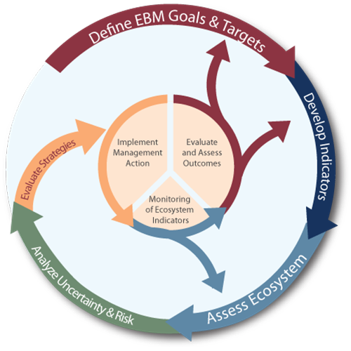 .image-cap[ https://www.integratedecosystemassessment.noaa.gov/national/IEA-approach ] ] ??? --- ## Fishery management in the US Eight regional Fishery Management Councils establish plans for sustainable management of stocks within their jurisdictions. All are governed by the same law, but tailor management to their regional stakeholder needs. 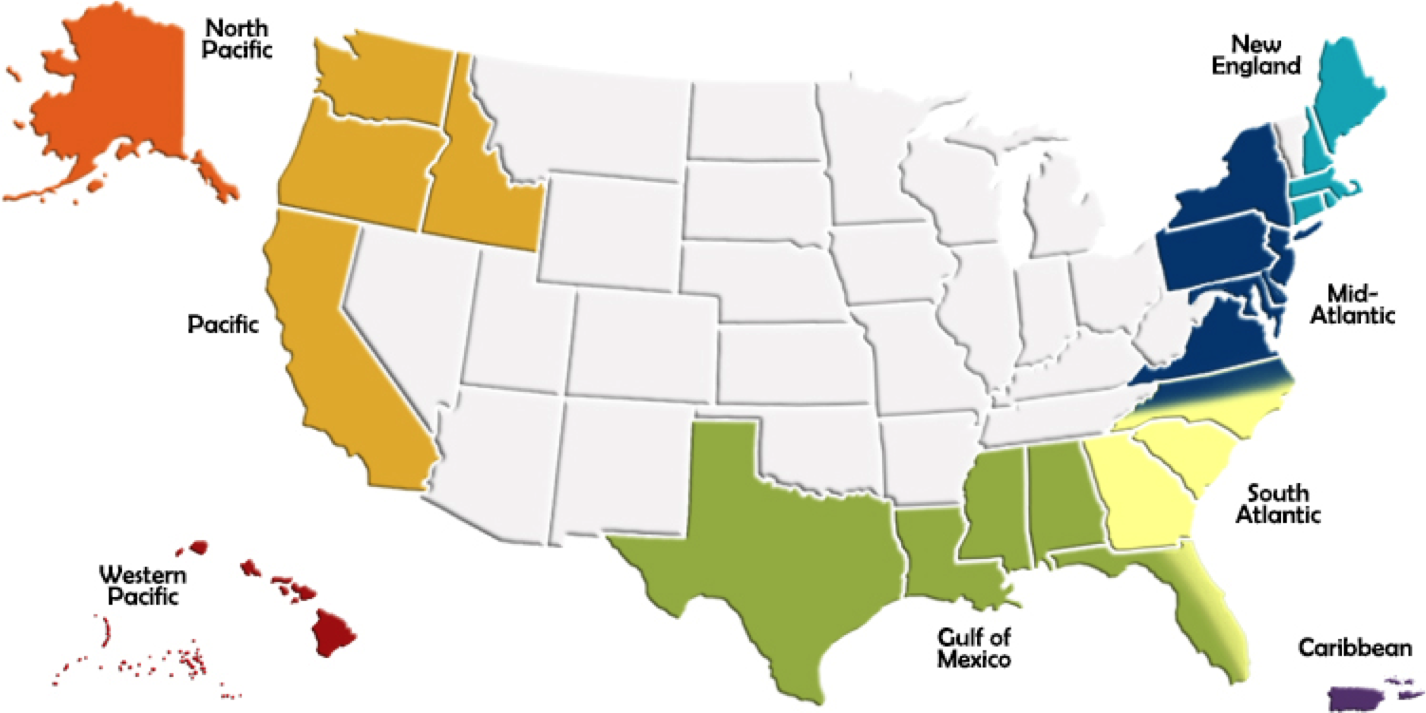 More information: http://www.fisherycouncils.org/ https://www.fisheries.noaa.gov/topic/laws-policies#magnuson-stevens-act --- ## The Mid-Atlantic Fishery Management Council .pull-left-30[ 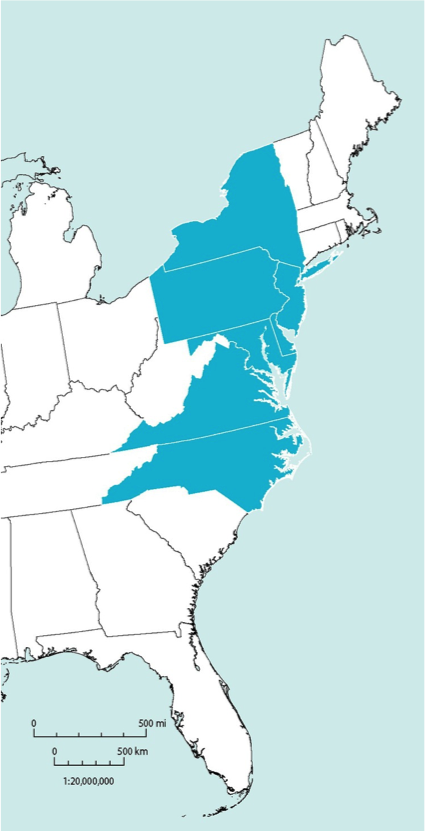 ] .pull-right-70[ 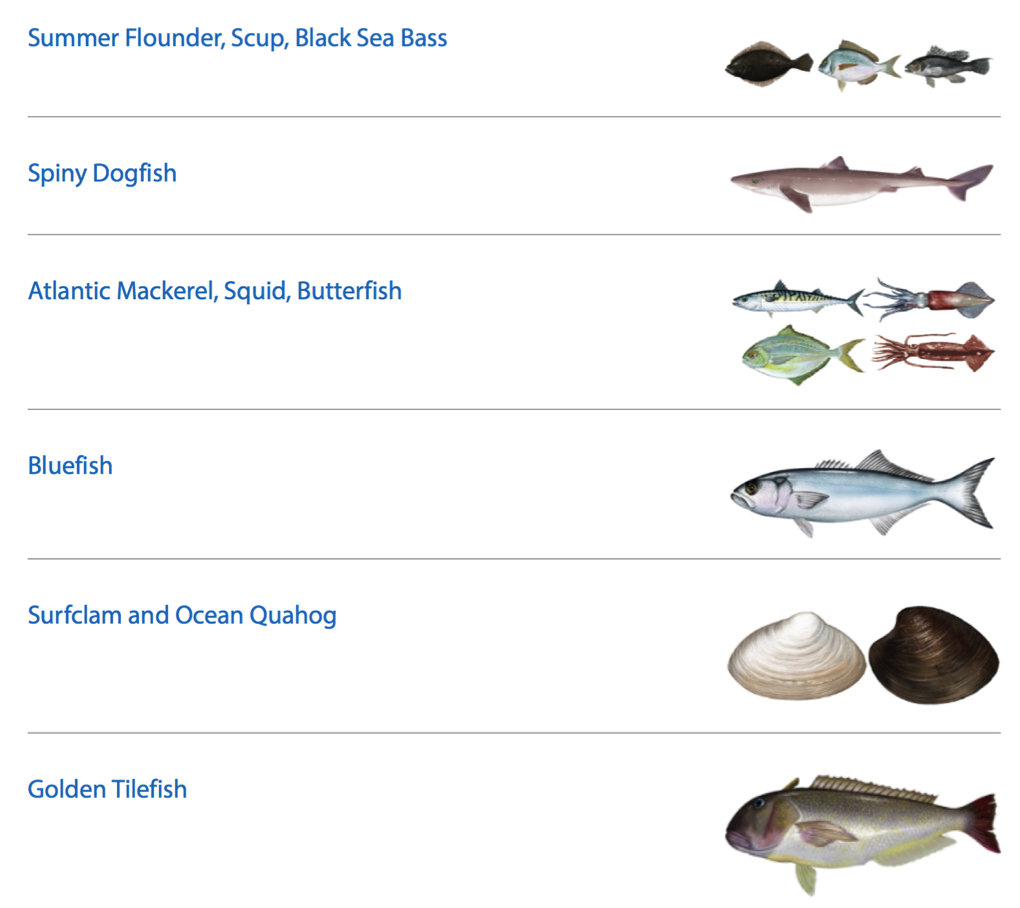 ] Source: http://www.mafmc.org/fishery-management-plans --- ## Why an ecosystem approach? *"We rebuilt all the stocks, so why is everyone still pissed off?" --Rich Seagraves* in 2011, the Council asked: .pull-left[ 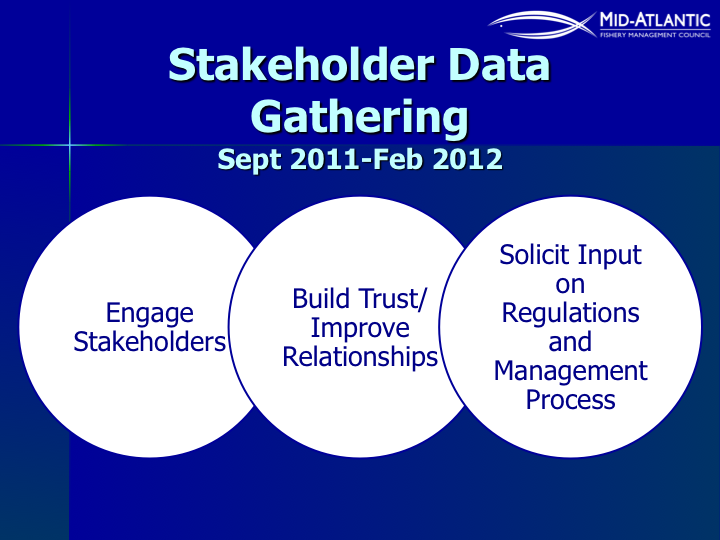 ] .pull-right[ 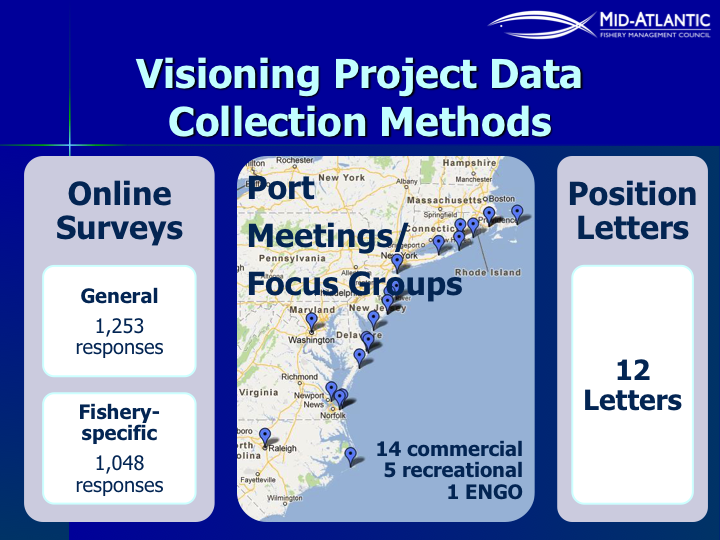 ] And many people answered, from commercial fishery, recreational fishery, environmental organization, and interested public perspectives. Visioning report: http://www.mafmc.org/s/MAFMC-stakeholder-input-report-p7b9.pdf --- ## Common themes among all stakeholder groups: >• There is a lack of confidence in the data that drive fishery management decisions. > >• Stakeholders are not as involved in the Council process as they can and should be. > >• Different jurisdictions and regulations among the many fishery management organizations result in complexity and inconsistency. > >• There is a need for increased transparency and communications in fisheries management. > >• The dynamics of the ecosystem and food web should be considered to a greater extent in fisheries management decisions. > >• Stakeholders are not adequately represented on the Council. > >• Pollution is negatively affecting the health of fish stocks. Visioning report, p. 3: http://www.mafmc.org/s/MAFMC-stakeholder-input-report-p7b9.pdf --- ## How did they develop their ecosystem approach? Visioning Project → Strategic Plan with one objective to develop >"A non-regulatory umbrella document intended to guide Council policy with respect to ecosystem considerations across existing Fishery Management Plans" <img src="EDAB_images/MAapproach.png" width="80%" style="display: block; margin: auto;" /> Details, including workshop presentations and white papers: http://www.mafmc.org/eafm --- ## Mid-Atlantic Council Ecosystem Approach * 2016 Ecosystem Approach to Fishery Management (EAFM) Policy Guidance document: http://www.mafmc.org/s/EAFM-Doc-Revised-2019-02-08.pdf * Mid-Atlantic EAFM framework<sup>1</sup>: <img src="EDAB_images/Framework.png" width="70%" style="display: block; margin: auto;" /> https://www.frontiersin.org/articles/10.3389/fmars.2016.00105/full .footnote[ [1] Gaichas, S., Seagraves, R., Coakley, J., DePiper, G., Guida, V., Hare, J., Rago, P., et al. 2016. A Framework for Incorporating Species, Fleet, Habitat, and Climate Interactions into Fishery Management. Frontiers in Marine Science, 3. ] --- ## Examples illustrating the use of the framework .pull-left-40[ 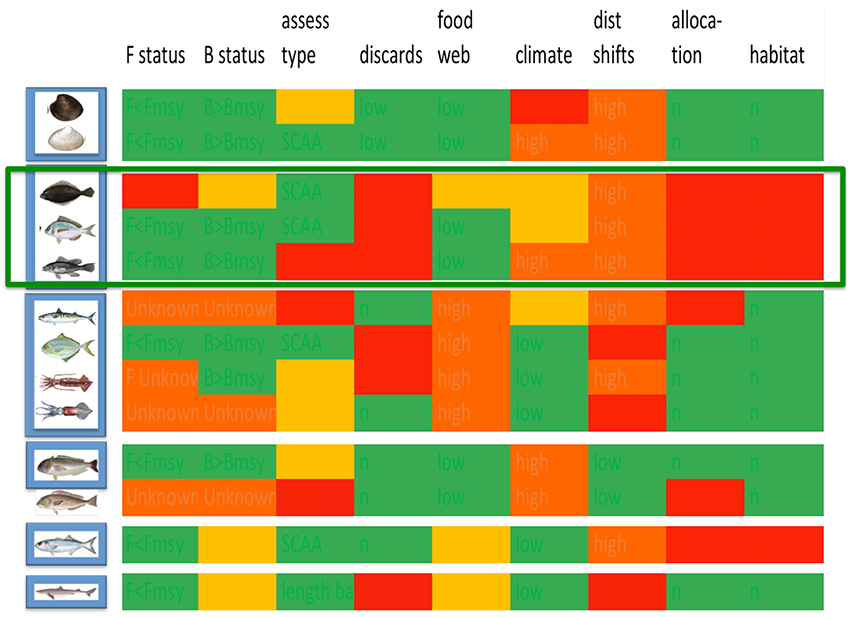 ] .pull-right-60[ Risk assessment highlights prority species/issues for more detailed evaluation A conceptual model maps out key interactions for high risk fisheries, specifies quantitative management strategy evaluation ] -- <img src="EDAB_images/fmars-03-00105-g011.jpg" width="78%" style="display: block; margin: auto 0 auto auto;" /> ??? The conceptual model is used to specify quantitative management strategy evaluation --- ## Why risk assessment? Common framework across industry, science, business; but methods matter. Assessing the risks correctly is essential to good decision making. <img src="EDAB_images/conditional_risk.png" width="70%" style="display: block; margin: auto;" /> https://xkcd.com/795/ --- ## Mid-Atlantic Council risk assessment framework Clarify exactly what we are assessing and why * *What are we measuring?* → **Risk Element** * *Why are we measuring it?* → **Risk Definition** * *How are we measuring it?* → **Indicator** * *What is the risk?* → **Risk Ranking Criteria** Iterative process starting with the Council workshops * Council staff and scientists create examples based on Council input ↑ ↓ ↑ ↓ ↑ ↓ ↑ ↓ ↑ ↓ ↑ ↓ ... * Council discusses, clarifies, revises with public input Risk assessment paper<sup>1</sup>: https://www.frontiersin.org/articles/10.3389/fmars.2018.00442/full .footnote[ [1] Gaichas, S. K., DePiper, G. S., Seagraves, R. J., Muffley, B. W., Sabo, M., Colburn, L. L., and Loftus, A. L. 2018. Implementing Ecosystem Approaches to Fishery Management: Risk Assessment in the US Mid-Atlantic. Frontiers in Marine Science, 5. ] --- ## Council-defined risk elements: Ecological <table class="table table-striped table-condensed" style="font-size: 14px; margin-left: auto; margin-right: auto;"> <thead> <tr> <th style="text-align:left;"> Element </th> <th style="text-align:left;"> Definition </th> <th style="text-align:left;"> Indicators </th> </tr> </thead> <tbody> <tr grouplength="11"><td colspan="3" style="border-bottom: 1px solid;"><strong>Ecological</strong></td></tr> <tr> <td style="text-align:left; padding-left: 2em;" indentlevel="1"> Assessment performance </td> <td style="text-align:left;"> Risk of not achieving OY due to analytical limitations </td> <td style="text-align:left;"> Current assessment method/data quality </td> </tr> <tr> <td style="text-align:left; padding-left: 2em;" indentlevel="1"> F status </td> <td style="text-align:left;"> Risk of not achieving OY due to overfishing </td> <td style="text-align:left;"> Current F relative to reference F from assessment </td> </tr> <tr> <td style="text-align:left; padding-left: 2em;" indentlevel="1"> B status </td> <td style="text-align:left;"> Risk of not achieving OY due to depleted stock </td> <td style="text-align:left;"> Current B relative to reference B from assessment </td> </tr> <tr> <td style="text-align:left; padding-left: 2em;" indentlevel="1"> Food web (MAFMC Predator) </td> <td style="text-align:left;"> Risk of not achieving OY due to MAFMC managed species interactions </td> <td style="text-align:left;"> Diet composition, management measures </td> </tr> <tr> <td style="text-align:left; padding-left: 2em;" indentlevel="1"> Food web (MAFMC Prey) </td> <td style="text-align:left;"> Risk of not achieving OY due to MAFMC managed species interactions </td> <td style="text-align:left;"> Diet composition, management measures </td> </tr> <tr> <td style="text-align:left; padding-left: 2em;" indentlevel="1"> Food web (Protected Species Prey) </td> <td style="text-align:left;"> Risk of not achieving protected species objectives due to species interactions </td> <td style="text-align:left;"> Diet composition, management measures </td> </tr> <tr> <td style="text-align:left; padding-left: 2em;" indentlevel="1"> Ecosystem productivity </td> <td style="text-align:left;"> Risk of not achieving OY due to changing system productivity </td> <td style="text-align:left;"> Four indicators, see text </td> </tr> <tr> <td style="text-align:left; padding-left: 2em;" indentlevel="1"> Climate </td> <td style="text-align:left;"> Risk of not achieving OY due to climate vulnerability </td> <td style="text-align:left;"> Northeast Climate Vulnerability Assessment </td> </tr> <tr> <td style="text-align:left; padding-left: 2em;" indentlevel="1"> Distribution shifts </td> <td style="text-align:left;"> Risk of not achieving OY due to climate-driven distribution shifts </td> <td style="text-align:left;"> Northeast Climate Vulnerability Assessment + 2 indicators </td> </tr> <tr> <td style="text-align:left; padding-left: 2em;" indentlevel="1"> Estuarine habitat </td> <td style="text-align:left;"> Risk of not achieving OY due to threats to estuarine/nursery habitat </td> <td style="text-align:left;"> Enumerated threats + estuarine dependence </td> </tr> <tr> <td style="text-align:left; padding-left: 2em;" indentlevel="1"> Offshore habitat </td> <td style="text-align:left;"> Risk of not achieving OY due to changing offshore habitat </td> <td style="text-align:left;"> Integrated habitat model index </td> </tr> </tbody> </table> --- ## Risk elements: Economic, Social, and Food Production <table class="table table-striped table-condensed" style="font-size: 14px; margin-left: auto; margin-right: auto;"> <thead> <tr> <th style="text-align:left;"> Element </th> <th style="text-align:left;"> Definition </th> <th style="text-align:left;"> Indicators </th> </tr> </thead> <tbody> <tr grouplength="4"><td colspan="3" style="border-bottom: 1px solid;"><strong>Economic</strong></td></tr> <tr> <td style="text-align:left; padding-left: 2em;" indentlevel="1"> Commercial Revenue </td> <td style="text-align:left;"> Risk of not maximizing fishery value </td> <td style="text-align:left;"> Revenue in aggregate </td> </tr> <tr> <td style="text-align:left; padding-left: 2em;" indentlevel="1"> Recreational Angler Days/Trips </td> <td style="text-align:left;"> Risk of not maximizing fishery value </td> <td style="text-align:left;"> Numbers of anglers and trips in aggregate </td> </tr> <tr> <td style="text-align:left; padding-left: 2em;" indentlevel="1"> Commercial Fishery Resilience (Revenue Diversity) </td> <td style="text-align:left;"> Risk of reduced fishery business resilience </td> <td style="text-align:left;"> Species diversity of revenue </td> </tr> <tr> <td style="text-align:left; padding-left: 2em;" indentlevel="1"> Commercial Fishery Resilience (Shoreside Support) </td> <td style="text-align:left;"> Risk of reduced fishery business resilience due to shoreside support infrastructure </td> <td style="text-align:left;"> Number of shoreside support businesses </td> </tr> <tr grouplength="2"><td colspan="3" style="border-bottom: 1px solid;"><strong>Social</strong></td></tr> <tr> <td style="text-align:left; padding-left: 2em;" indentlevel="1"> Fleet Resilience </td> <td style="text-align:left;"> Risk of reduced fishery resilience </td> <td style="text-align:left;"> Number of fleets, fleet diversity </td> </tr> <tr> <td style="text-align:left; padding-left: 2em;" indentlevel="1"> Social-Cultural </td> <td style="text-align:left;"> Risk of reduced community resilience </td> <td style="text-align:left;"> Community vulnerability, fishery engagement and reliance </td> </tr> <tr grouplength="2"><td colspan="3" style="border-bottom: 1px solid;"><strong>Food Production</strong></td></tr> <tr> <td style="text-align:left; padding-left: 2em;" indentlevel="1"> Commercial </td> <td style="text-align:left;"> Risk of not optimizing seafood production </td> <td style="text-align:left;"> Seafood landings in aggregate </td> </tr> <tr> <td style="text-align:left; padding-left: 2em;" indentlevel="1"> Recreational </td> <td style="text-align:left;"> Risk of not maintaining personal food production </td> <td style="text-align:left;"> Recreational landings in aggregate </td> </tr> </tbody> </table> --- ## Risk elements: Management <table class="table table-striped table-condensed" style="font-size: 14px; margin-left: auto; margin-right: auto;"> <thead> <tr> <th style="text-align:left;"> Element </th> <th style="text-align:left;"> Definition </th> <th style="text-align:left;"> Indicators </th> </tr> </thead> <tbody> <tr grouplength="6"><td colspan="3" style="border-bottom: 1px solid;"><strong>Management</strong></td></tr> <tr> <td style="text-align:left; padding-left: 2em;" indentlevel="1"> Control </td> <td style="text-align:left;"> Risk of not achieving OY due to inadequate control </td> <td style="text-align:left;"> Catch compared to allocation </td> </tr> <tr> <td style="text-align:left; padding-left: 2em;" indentlevel="1"> Interactions </td> <td style="text-align:left;"> Risk of not achieving OY due to interactions with species managed by other entities </td> <td style="text-align:left;"> Number and type of interactions with protected or non-MAFMC managed species, co-management </td> </tr> <tr> <td style="text-align:left; padding-left: 2em;" indentlevel="1"> Other ocean uses </td> <td style="text-align:left;"> Risk of not achieving OY due to other human uses </td> <td style="text-align:left;"> Fishery overlap with energy/mining areas </td> </tr> <tr> <td style="text-align:left; padding-left: 2em;" indentlevel="1"> Regulatory complexity </td> <td style="text-align:left;"> Risk of not achieving compliance due to complexity </td> <td style="text-align:left;"> Number of regulations by species </td> </tr> <tr> <td style="text-align:left; padding-left: 2em;" indentlevel="1"> Discards </td> <td style="text-align:left;"> Risk of not minimizing bycatch to extent practicable </td> <td style="text-align:left;"> Standardized Bycatch Reporting </td> </tr> <tr> <td style="text-align:left; padding-left: 2em;" indentlevel="1"> Allocation </td> <td style="text-align:left;"> Risk of not achieving OY due to spatial mismatch of stocks and management </td> <td style="text-align:left;"> Distribution shifts + number of interests </td> </tr> </tbody> </table> --- background-image: url("EDAB_images/IMG_2246.jpg") background-size: cover ## <center>But where will the indicators come from?</center> --- ## Meanwhile, scientists were improving ecosystem reports: *"So what?" --John Boreman, September 2016* 1. Clear linkage of ecosystem indicators with management objectives 1. Synthesis across indicators for big picture 1. Objectives related to human-well being placed first in report 1. Short (< 30 pages), non-technical (but rigorous) text 1. Emphasis on reproducibility <img src="EDAB_images/nes-components-abstracted.png" width="60%" style="display: block; margin: auto;" /> ??? In 2016, we began taking steps to address these common critiques of the ESR model --- ## Revised ecosystem status reporting .pull-left[ ### Report structure 0. Synthetic overview 1. Human dimensions 2. Protected species 3. Fish and invertebrates (managed and otherwise) 4. Habitat quality and ecosystem productivity ] .pull-right[ .table[ <table class="table" style="width: 50; margin-left: auto; margin-right: auto;"> <caption>Ecosystem-scale objectives and indicators on the Northeast US shelf</caption> <thead> <tr> <th style="text-align:left;font-weight: bold;"> Objective Categories </th> <th style="text-align:left;font-weight: bold;"> Indicators </th> </tr> </thead> <tbody> <tr> <td style="text-align:left;"> Seafood Production </td> <td style="text-align:left;"> Landings by feeding guild </td> </tr> <tr> <td style="text-align:left;"> Profits </td> <td style="text-align:left;"> Revenue by feeding guild </td> </tr> <tr> <td style="text-align:left;"> Recreation </td> <td style="text-align:left;"> Number of anglers and trips; recreational catch </td> </tr> <tr> <td style="text-align:left;"> Stability </td> <td style="text-align:left;"> Diversity indices (fishery and species) </td> </tr> <tr> <td style="text-align:left;"> Social & Cultural </td> <td style="text-align:left;"> Commercial and recreational reliance </td> </tr> <tr> <td style="text-align:left;"> Biomass </td> <td style="text-align:left;"> Biomass or abundance by feeding guild from surveys </td> </tr> <tr> <td style="text-align:left;"> Productivity </td> <td style="text-align:left;"> Condition and recruitment of managed species </td> </tr> <tr> <td style="text-align:left;"> Trophic structure </td> <td style="text-align:left;"> Relative biomass of feeding guilds, primary productivity </td> </tr> <tr> <td style="text-align:left;"> Habitat </td> <td style="text-align:left;"> Estuarine and offshore habitat conditions </td> </tr> </tbody> </table> ] ] --- ## Standardized indicator visualization in reports Status (short-term) and trend (long-term) of components are measured as **indicators** and plotted in a standardized way Indicators are selected to 1. Be broadly informative about a component in a management context<sup>1-3</sup> 1. Minimize redundancy of information 1. Be responsive to ecosystem change <img src="20190529_IMR_Gaichas_files/figure-html/doc-orientation-1.png" style="display: block; margin: auto;" /> .footnote[ [1] Rice J. C.Rochet M. J. "A framework for selecting a suite of indicators for fisheries management." ICES Journal of Marine Science 62 (2005): 516–527. [2] Link J. 2010. Ecosystem-Based Fisheries Management: Confronting Tradeoffs . Cambridge University Press, New York. [3] Zador, Stephani G., et al. "Ecosystem considerations in Alaska: the value of qualitative assessments." ICES Journal of Marine Science 74.1 (2017): 421-430. ] --- ## Indicator spatial scales--already Mid-Atlantic specific <img src="EDAB_images/SOE_Map.jpg" width="70%" style="display: block; margin: auto;" /> .footnote[ https://noaa-edab.github.io/tech-doc/epu.html ] ??? Indicators --- ## Risk assessent indicators and ranking criteria: Commercial revenue This element is applied at the ecosystem level. Revenue serves as a proxy for commercial profits. .table[ .pull-left[ | Risk Level | Definition | |:-------------------|:--------------------------------------------------------------------| | Low | No trend and low variability in revenue | | Low-Moderate | Increasing or high variability in revenue | | Moderate-High | Significant long term revenue decrease | | High | Significant recent decrease in revenue | ] ] .pull-right[ 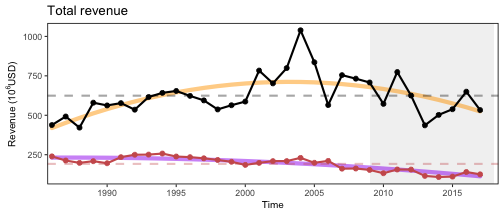<!-- --> 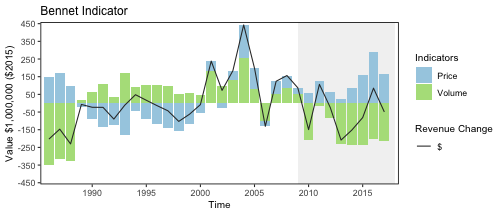<!-- --> ] Ranked moderate-high risk due to the significant long term revenue decrease for Mid-Atlantic managed species (red points in top plot) --- ## Risk assessent indicators and ranking criteria: System productivity This element is applied at the ecosystem level, and ranks the risk of not achieving optimum yield due to changes in ecosystem productivity at the base of the food web. Four indicators are used together to assess risk of changing ecosystem productivity: primary production, zooplankton abundance, fish condition and fish recruitment. .table[ | Risk Level | Definition | |:-------------------|:--------------------------------------------------------------------| | Low | No trends in ecosystem productivity | | Low-Moderate | Trend in ecosystem productivity (1-2 measures, increase or decrease) | | Moderate-High | Trend in ecosystem productivity (3+ measures, increase or decrease) | | High | Decreasing trend in ecosystem productivity, all measures | ] ??? We examine trends in total primary production, zooplankton abundance for a key Mid-Atlantic species, and two aggregate fish productivity measures: condition factor (weight divided by length of individual fish) and a survey based "recruitment" (small fish to large fish) index. --- ## Risk assessent indicators and ranking criteria: System productivity .pull-left[ 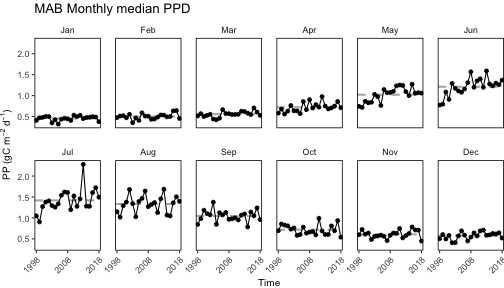<!-- --> <img src="EDAB_images/MAFMC_Fish_Condition_2019.jpg" width="2109" style="display: block; margin: auto;" /> ] .pull-right[ 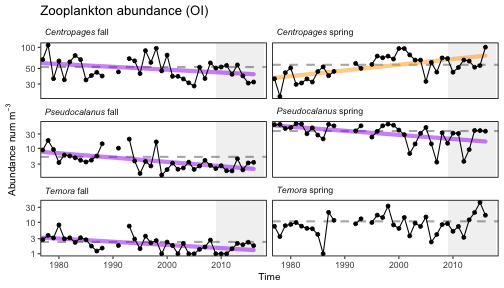<!-- --> 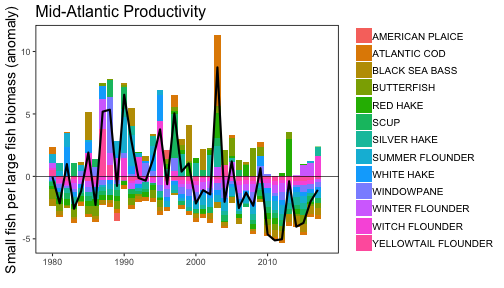<!-- --> ] Ranked low-moderate risk due to the significant long term trends in zooplankton abundance for major species (top right plot) --- ## Risk assessent indicators and ranking criteria: Climate This element is applied at the species level. Risks to species productivity (and therefore to achieving optimum yield) due to projected climate change in the Northeast US were evaluated in a comprehensive assessment<sup>1</sup>. .table[ .pull-left[ | Risk Level | Definition | |:-------------------|:--------------------------------------------------------------------| | Low | Low climate vulnerability ranking | | Low-Moderate | Moderate climate vulnerability ranking | | Moderate-High | High climate vulnerability ranking | | High | Very high climate vulnerability ranking | ] ] .pull-right[ <img src="EDAB_images/journal.pone.0146756.g003.PNG" width="100%" /> .image-cap[https://journals.plos.org/plosone/article?id=10.1371/journal.pone.0146756.] ] .footnote[ [1] Hare, J. A., Morrison, W. E., Nelson, M. W., Stachura, M. M., Teeters, E. J., Griffis, R. B., Alexander, M. A., et al. 2016. A Vulnerability Assessment of Fish and Invertebrates to Climate Change on the Northeast U.S. Continental Shelf. PLOS ONE, 11: e0146756. ] Each species ranked according to position/color in the plot on the right --- ## Risk assessment results, 2017-2018 *Species level risk summary* 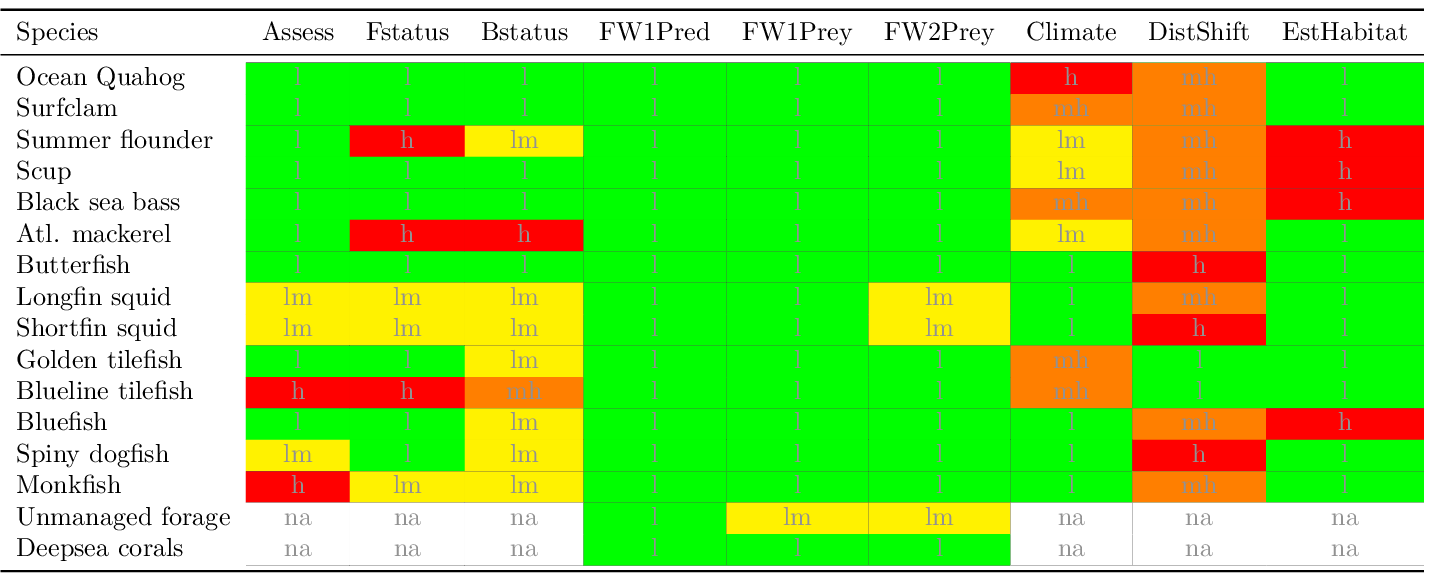 *Ecosystem level risk summary*  --- ## Risk assessment results, 2017-2018 (and 2019) *Species and Sector level risk elements* <img src="EDAB_images/mgttable2019.png" width="85%" style="display: block; margin: auto;" /> --- ## EAFM risk assessment update 2019 The Mid-Atlantic Council requested that the State of the Ecosystem report indicators be used to annually update their EAFM risk assessment. *Therefore, ecosystem reporting now has a direct strategic use.* ### Decreased risk * Summer flounder fishing mortality (F) status has improved from high risk (F>Fmsy) to low risk (F<Fmsy) based on the new benchmark assessment * Updated commercial fleet diversity (fleet count and fleet diversity) have no long term trends, thus improving from moderate-high risk to low risk according to risk criteria for this element ### Increased risk * None according to the current Council risk critiera --- ## EAFM risk assessment update 2019 *Species level risk elements* <img src="EDAB_images/sptable2019.png" width="95%" style="display: block; margin: auto;" /> *Ecosystem level risk elements* <img src="EDAB_images/ecotable2019.png" width="95%" style="display: block; margin: auto;" /> --- ## How are they using the risk assessment? What's next? * Based on risk assessment, the Council selected summer flounder as high-risk fishery for conceptual modeling <img src="EDAB_images/Framework.png" width="60%" style="display: block; margin: auto;" /> * Working group of habitat, biology, stock assessment, management, economic and social scientists are now developing: * draft conceptual models of high risk elements, linkages * dataset identification and gap analysis for each element and link * draft questions that the Council could persue with additional work --- ## Mid-Atlantic Council ecosystem approach continued... * The late 2018 summer flounder conceptual model, now under construction: <img src="EDAB_images/Summerfl_EAFM_v2.png" width="60%" style="display: block; margin: auto;" /> * Final conceptual modeling to be done by late 2019 * Council may then elect to proceed with management strategy evaluation (MSE) using the information from conceptual modeling as a basis --- ## Footnote: Improvements to reproducibility and provenance * Reporting the information is not enough * Managers appreciate the concise format, but back-end critical for describing collection, analyses, and processing * Streamlined workflow allowed scientists to meet management deadlines 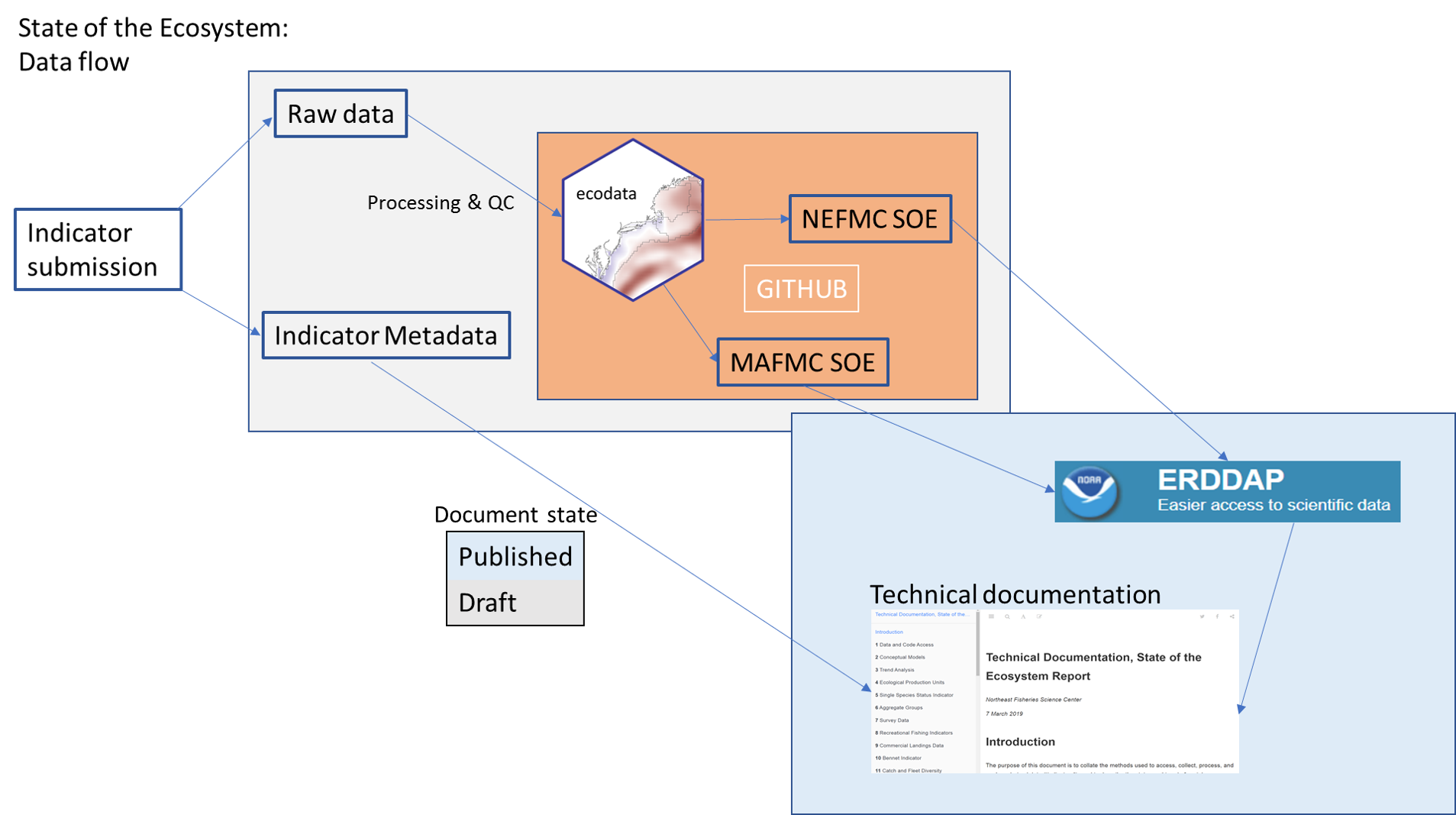 ??? This workflows also ensures that there's no information lost between SOE cycles. We know exactly how a data set was analyzed and handled so that the data can be updated for next year's reports. --- ## If you want **all** the details * [State of the Ecosystem Technical Documentation](https://noaa-edab.github.io/tech-doc) * [ecodata R package](https://github.com/noaa-edab/ecodata) * [Macrofauna indicators](http://noaa-edab.github.io/ecodata/macrofauna) * [Human Dimensions indicators](http://noaa-edab.github.io/ecodata/human_dimensions) * [Lower trophic level indicators](http://noaa-edab.github.io/ecodata/LTL) * [ERDDAP server](https://comet.nefsc.noaa.gov/erddap/index.html) * Slides available at https://noaa-edab.github.io/presentations --- ## Conclusions Risk assessment is valuable for the general implementation of ecosystem approaches to natural resource management * Risk assessment is a rapid, familiar, scaleable, and transparent method to move forward with EAFM within a real-world operational fishery management context * Risk assessment can be conducted collaboratively within existing stakeholder processes * This EAFM risk assessment highlights certain species and certain management issues as posing higher cumulative risks to meeting Council-derived management objectives when considering a broad range of ecological, social, and economic factors * The Council foresees refining the process so that ecosystem indicators monitor risks to achieving ecological, social, and economic fishery objectives, which can then be mitigated through management action. --- ## Contributors - THANK YOU! The New England and Mid-Atlantic Ecosystem reports made possible by (at least) 38 contributors from 8 institutions .pull-left[ .contrib[ Donald Anderson (Woods Hole Oceanographic Institute) <br> Amani Bassyouni (Virginia Department of Health)<br> Lisa Calvo (Rutgers)<br> Matthew Camisa (MA Division of Marine Fisheries) <br> Patricia Clay<br> Lisa Colburn<br> Geret DePiper<br> Deb Duarte<br> Michael Fogarty<br> Paula Fratantoni <br> Kevin Friedland<br> Sarah Gaichas<br> James Gartland (Virginia Institute of Marine Science)<br> Heather Haas<br> Sean Hardison <br> Kimberly Hyde<br> Terry Joyce (Woods Hole Oceanographic Institute)<br> John Kosik<br> Steve Kress (National Audubon Society)<br> Scott Large ] ] .pull-right[ .contrib[ Don Lyons (National Audubon Society)<br> Loren Kellogg<br> David Kulis (Woods Hole Oceanographic Institute)<br> Sean Lucey<br> Chris Melrose<br> Ryan Morse<br> Kimberly Murray<br> Chris Orphanides<br> Richard Pace<br> Charles Perretti<br> Karl Roscher (Maryland Department of Natural Resources)<br> Vincent Saba<br> Laurel Smith<br> Mark Terceiro<br> John Walden<br> Harvey Walsh<br> Mark Wuenschel<br> Qian Zhang (Unversity of Maryland and US EPA Chesapeake Bay Program) ] ] <img src="EDAB_images/noaa-iea.png" width="50%" style="display: block; margin: auto;" /> --- background-image: url("EDAB_images/IMG_2733.jpg") background-size: cover ## Questions? # Tusen Takk til Havforskningsinstituttet!